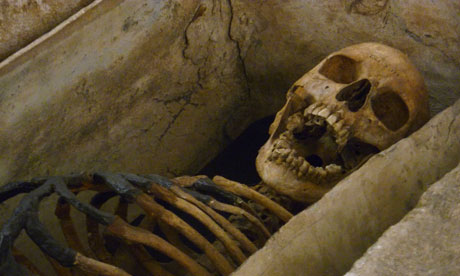
The
Roman skeleton that inspired Sylvia Plath. It had been taken off
display due to overcrowding. Photograph: Cambridge Museum of
Archaeology and Anthropology
The skeleton of a Roman woman and the bones of the mouse and shrew that gnawed her ankle in her coffin, inspiring one of Sylvia Plath's most haunting poems, have gone on display.
Plath saw the massive stone sarcophagus and its contents soon after it was excavated in the 1950s, when she was a student at Cambridge.
Staff at the university's Museum of Archaeology and Anthropology mounted the rodent bones on a piece of card – also on display again – and showed them in the coffin alongside the remains of the middle-aged woman, which is grimacing as if in pain.
Plath saw the massive stone sarcophagus and its contents soon after it was excavated in the 1950s, when she was a student at Cambridge.
Staff at the university's Museum of Archaeology and Anthropology mounted the rodent bones on a piece of card – also on display again – and showed them in the coffin alongside the remains of the middle-aged woman, which is grimacing as if in pain.
No comments:
Post a Comment
Note: Only a member of this blog may post a comment.